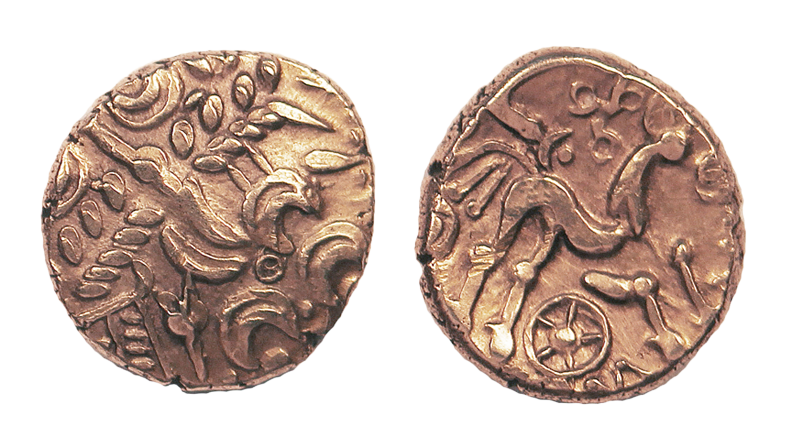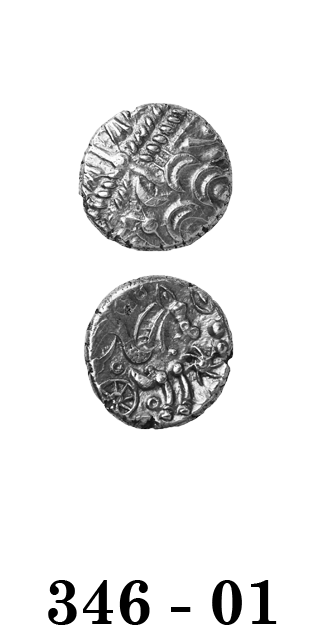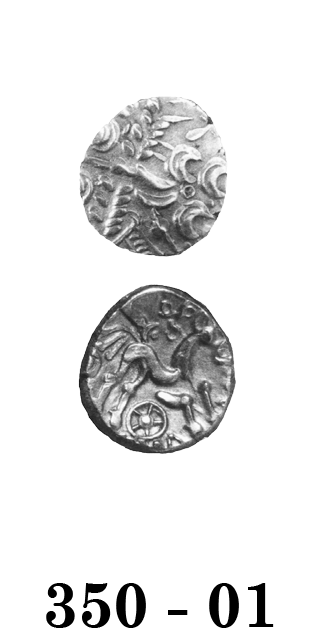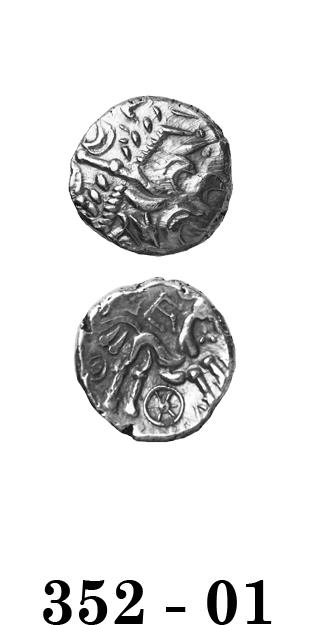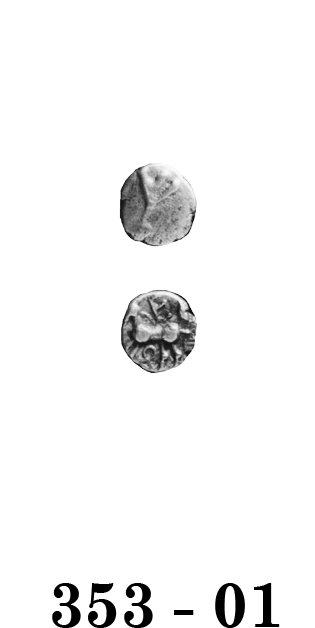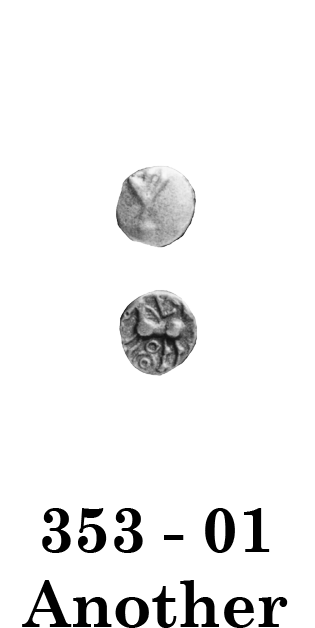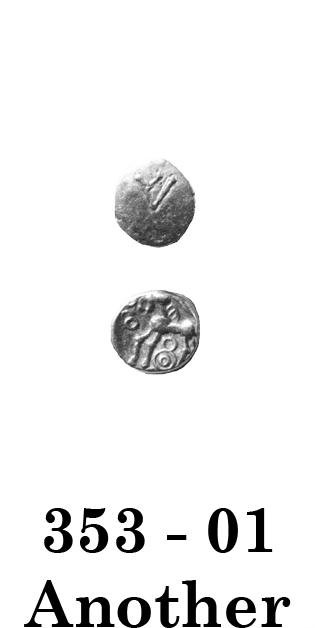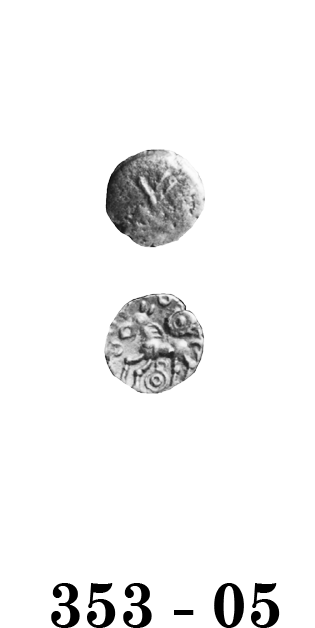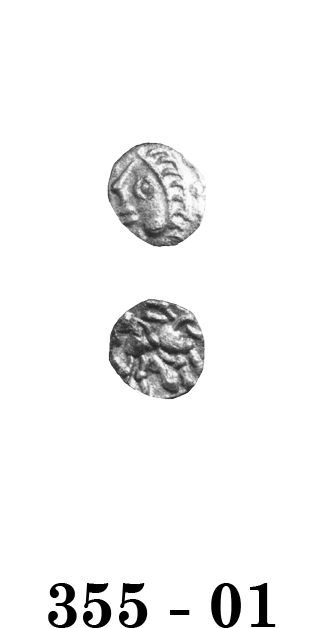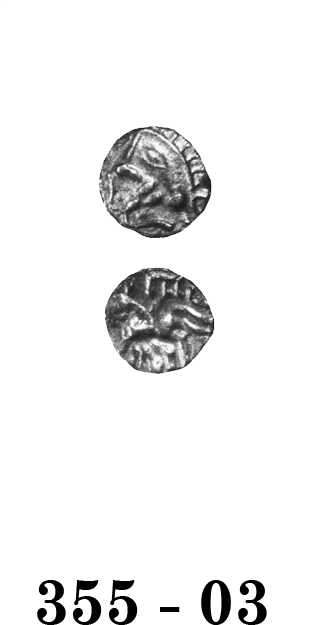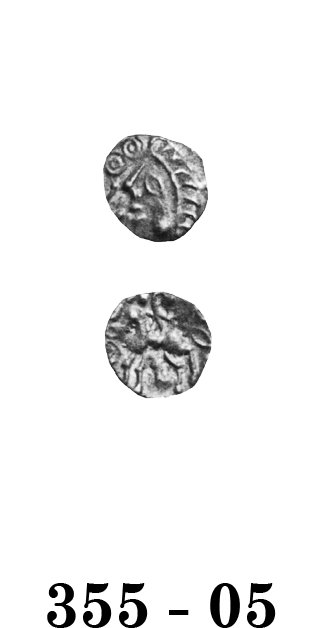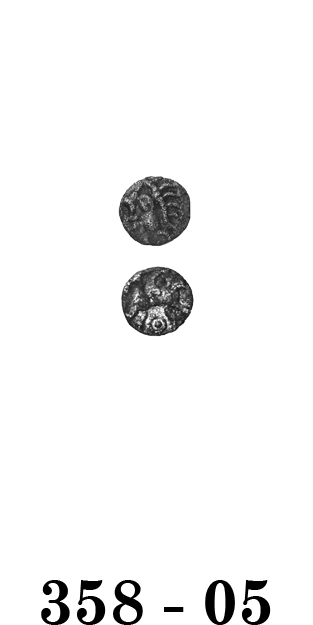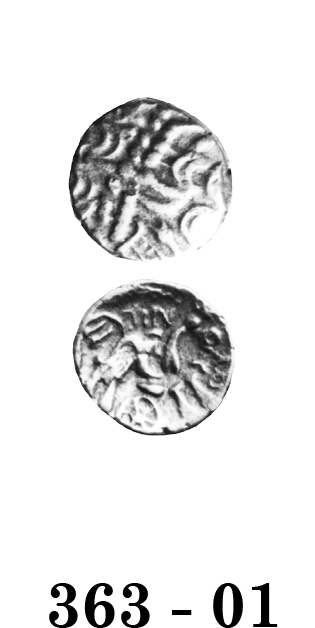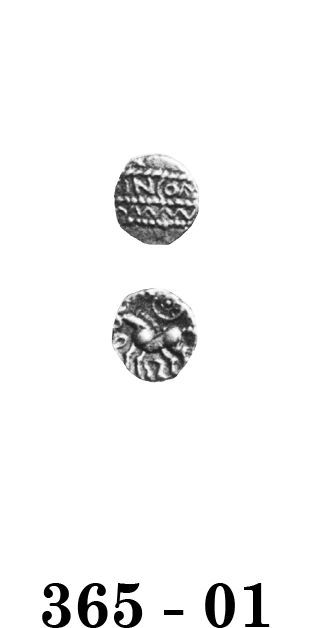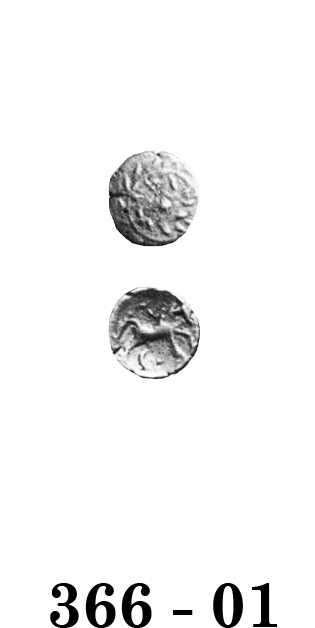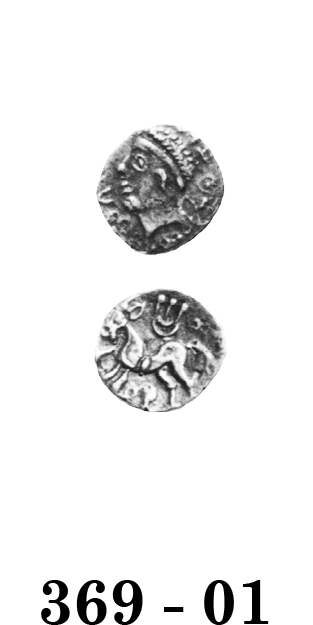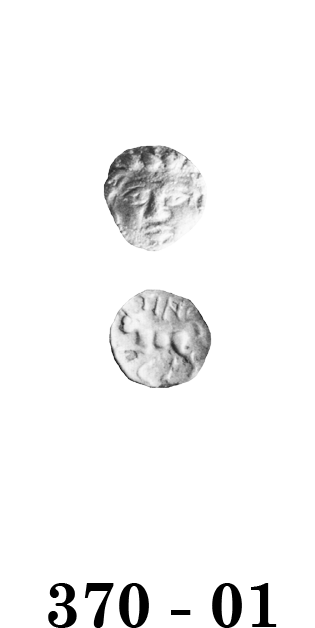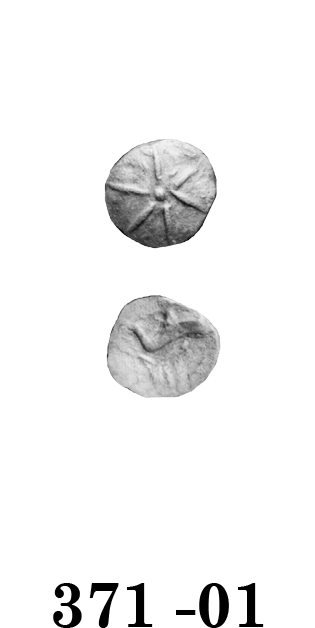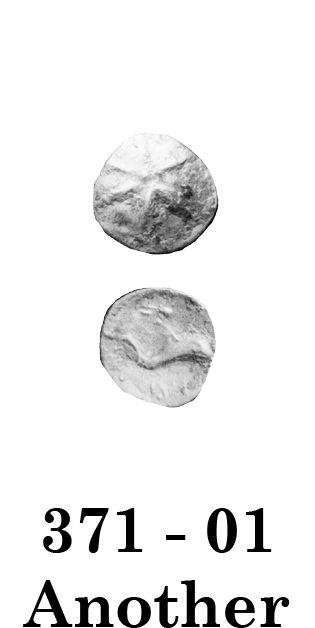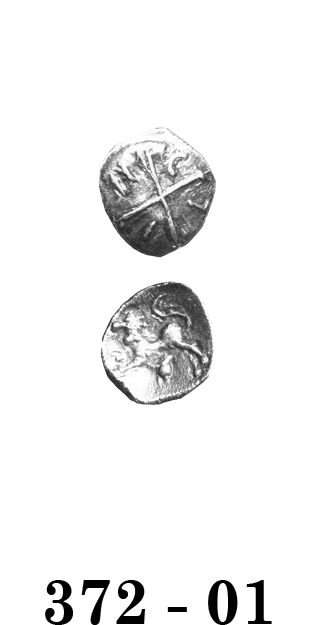
Celtic Coinage of Britain
third edition
Click on coin to see hidden information
Atrebates, Regni & Belgae Dynastic Coinages
The arrangement of the dynastic coins follows that in Van Arsdell, 1989. For a different arrangement of these coins see Bean, 2000.
Coinage of Commius
Commius came to Britain after the battle of Alesia to join the British Atrebates. He quickly became their leader because his name soon appears on the Atrebatic staters. These are like the Early Atrebatic Type, but have COMMIOS inscribed below the horse. Two types are known, one has an 'E symbol' that also appears on some rare silver units, and this symbol has been used to identify Commius' silver coinage. An earlier type stater, lacking an inscription has been identified after 1989.
Commius' quarter staters have also been identified. These had previously been attributed as 'Gallo-Belgic XC2', but one variety has the same upright 'E' symbol as found on the silver units. A partial inscription, 'CO', appears in front of the horse. The mane of the horse, and the double-stranded tail also link the silver and gold quarters. The quarter staters are almost always found in Britain, in Atrebatic territory, they do not occur on the Continent.
A silver unit with a wheel, and a quarter stater with an anemone are identical in style to the 'E' symbol types, and are undoubtedly part of the same coinage. Thus the coinage of Commius is now seen to be made up of gold staters, quarter staters and silver units, all linked by stylistic details and privy marks.
Coinage of Tincomarus
The next name appearing on the coins is Tincomarus. His rule, lasting about 25 years, ended during the Trinovantian/Catuvellaunian Interregnum. Tincomarus afterwards appears in Rome seeking assistance from Augustus – evidently he had been deposed. The historical Tincomarus, mentioned on the Monumentum Ancyranum (constructed about 7 A.D.) has traditionally been associated with the Atrebatic coins.
Tincomarus' coinage is divided into three periods based on the stater types. The corresponding quarter staters and silver coins are assigned according to their inscriptions and on typological grounds. The more Romanized designs on the silver are assigned to the later periods.
Originally, this ruler was known as Tincommius, however, a more complete inscription on an Alton Hoard coin has provided a better reading of the name.
Tincomarus First Coinage
Tincomarus first staters continue the imagery of the uninscribed coins and those of Commius.
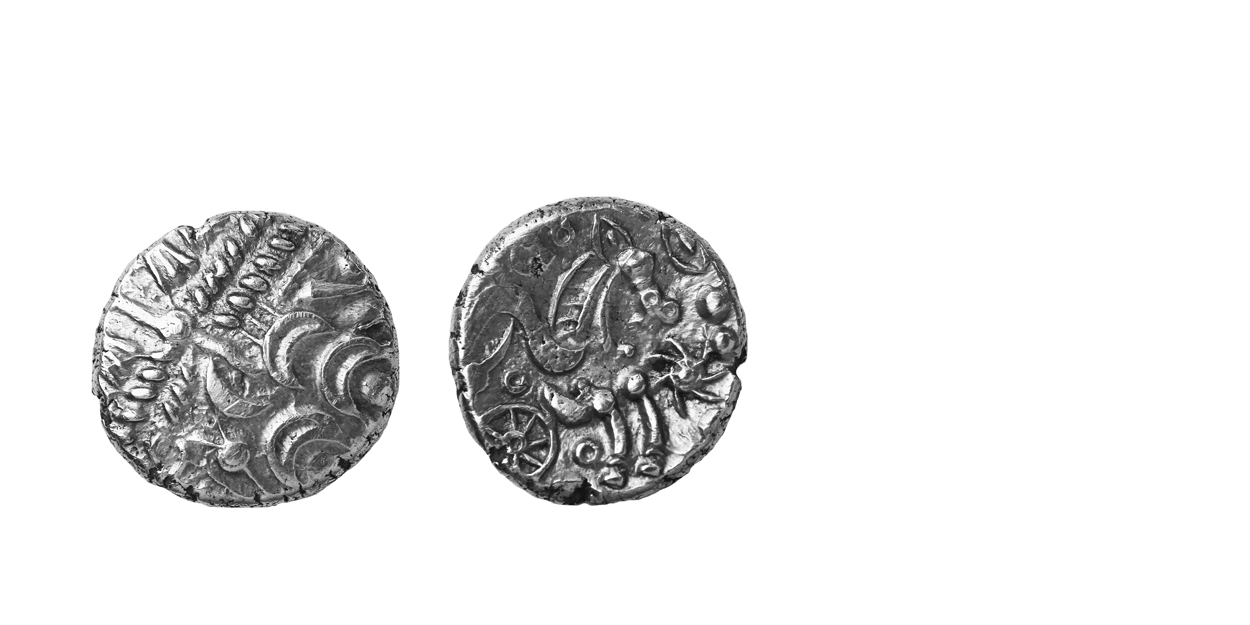
346 - 01 Commius
45-30 B.C. Extremely Rare
Gold Stater 5.5 gms. 17 mm
Earliest Record: Van Arsdell, 1992
OBV: Celticized head of Apollo right
Identifying points:
1) wreath: leaves downwards
2) spike made up of lines and large pellets
3) three lines connect wreath to curl above hook of spike
4) Hidden "bird face" at 2 o'clock
5) "ladder" for horse's mane
REV: Celticized horse right
Identifying points:
1) eight-spoked wheel with axle below horse
2) three-ringed object, similar to Llyn Cerrig Bach gang-chain above horse
3) seven-armed spiral in fron to horse
CLASSIFICATION: Atrebatic C
NOTES:
- Actual weight of existing examplegiven
- Inscription "Commios", if present, is off the flan on the illustrated example
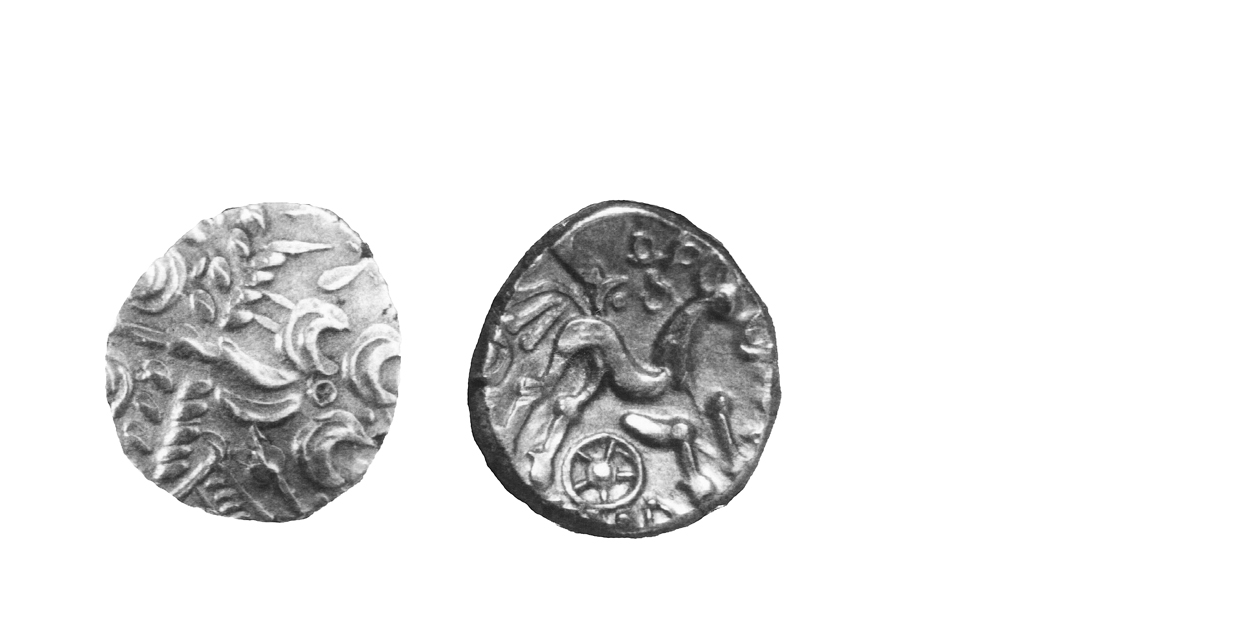
350 - 01 Commius
45-30 B.C. Scarce
Gold Stater 5.45 gms. 17 mm
Earliest Record: Evans, 1864
OBV: Celticized head of Apollo right
Identifying points:
1) wreath: leaves downwards
2) spike made up of lines and large pellets
3) two lines connect wreath to curl above hook of spike
4) ring or pellet near hook
5) Pellet between curls
REV: Celticized horse right
Identifying points:
1) five-spoked wheel with axle below horse
2) COMMIOS below horse
3) triple-tail on horse
4) three-ringed object, similar to Llyn Cerrig Bach gang-chain
5) vestige of charioteer's arms reduced to a thick line with a curve and pellet at the end
CLASSIFICATION: Atrebatic C
NOTES:
- Standard weight estimated, the true standard is probably 0.1 to 0.2 grammes heavier
- Some in museums
- The alternate use of the ring or pellet near hook may constitute a privy mark
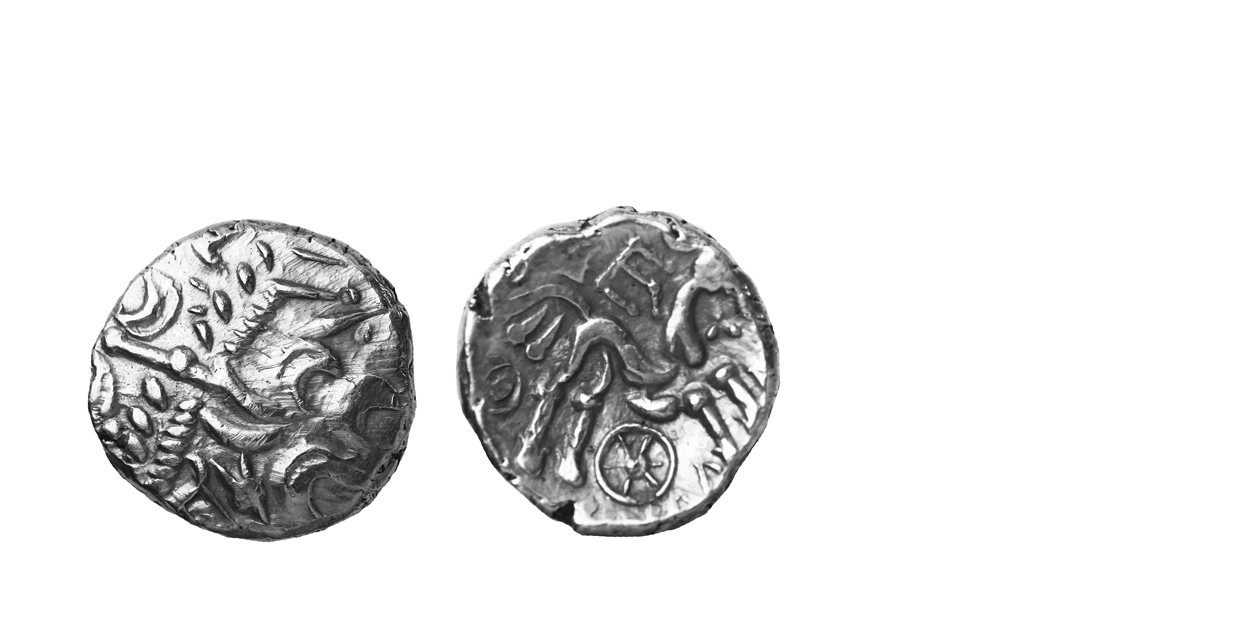
352 - 01 Commius
45-30 B.C. Extremely Rare
Gold Stater 5.45 gms. 17 mm
Earliest Record: Van Arsdell, 1986h
OBV: Celticized head of Apollo right
Identifying points:
1) as 350 - 01
REV: Celticized horse right
Identifying points:
1) similar to 350 - 01
2) six-spoked wheel with axle below horse
3) 'E' symbol' above horse
CLASSIFICATION: Atrebatic C
NOTES:
- Standard weight estimated, the true standard is probably 0.1 to 0.2 grammes heavier
- Change from five to six-spoked wheel with axle may be a privy mark
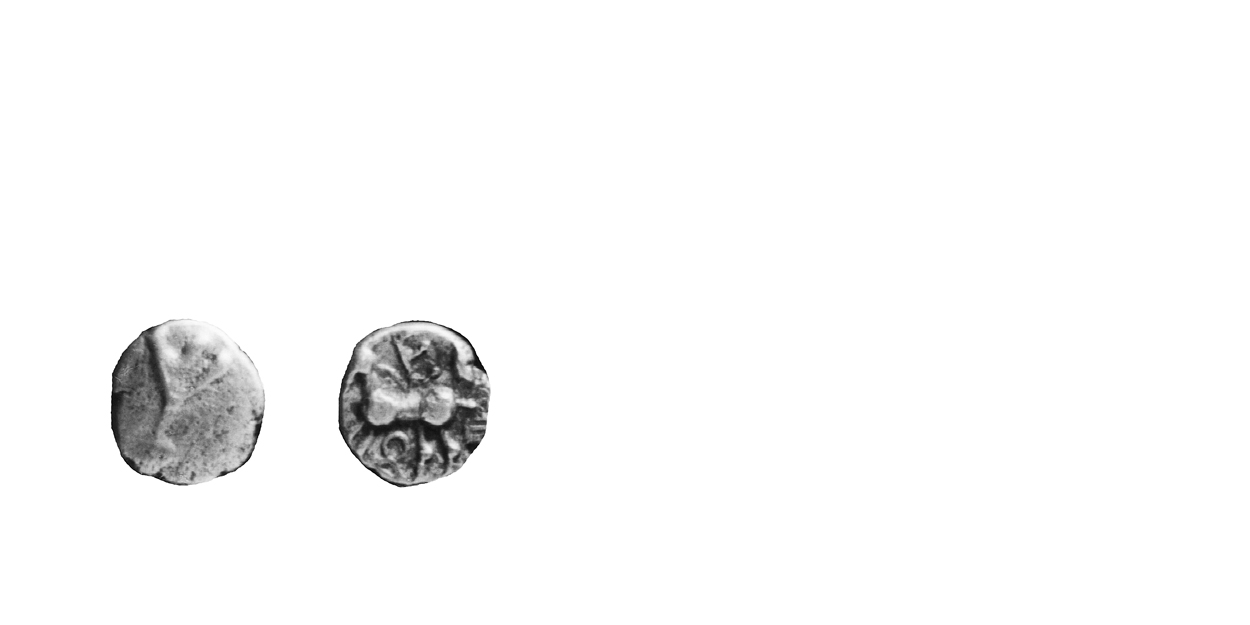
353 - 01 Upright E Type
45-30 B.C. Extremely Rare
Gold Quarter Stater 1.35 gms. 8 mm
Earliest Record: Evans, 1864
OBV: Digamma on blank field
REV: Celticized horse left
Identifying points:
1) below horse, figure-of-eight with ring in lower loop
2) 'E' symbol above horse, with arms of E pointing right
3) middle arm of E is bent downwards
4) mane made up of curve with lines
5) CO in front of horse
6) double-stranded tail
CLASSIFICATION: Atrebatic C
NOTES:
- Standard weight given
- Celtic Coin Index records indicate rarer than originally thought
- Continental type, possibly of of Commius exists, see 87 - 01
- Many in museums
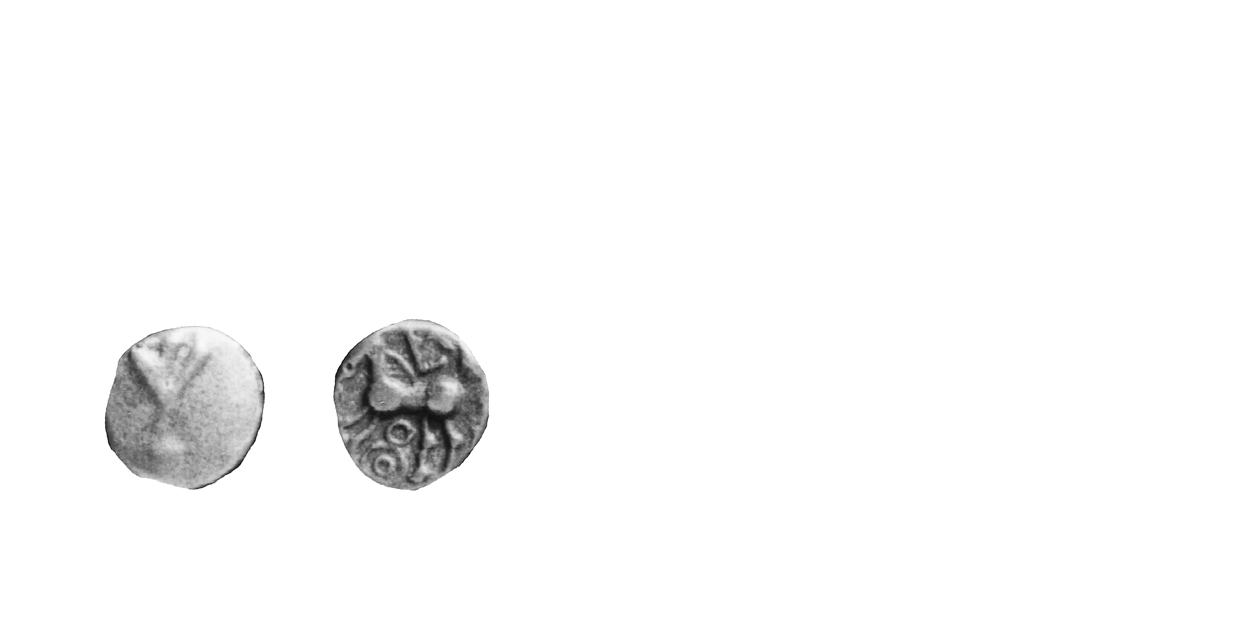
353 - 01 Upright E Type
45-30 B.C. Extremely Rare
Gold Quarter Stater 1.35 gms. 8 mm
Earliest Record: Evans, 1864
OBV: Digamma on blank field
REV: Celticized horse left
Identifying points:
1) below horse, figure-of-eight with ring in lower loop
2) 'E' symbol above horse, with arms of E pointing right
3) middle arm of E is bent downwards
4) mane made up of curve with lines
5) CO in front of horse
6) double-stranded tail
CLASSIFICATION: Atrebatic C
NOTES:
- Standard weight given
- Celtic Coin Index records indicate rarer than originally thought
- Continental type, possibly of of Commius exists, see 87 - 01
- Many in museums
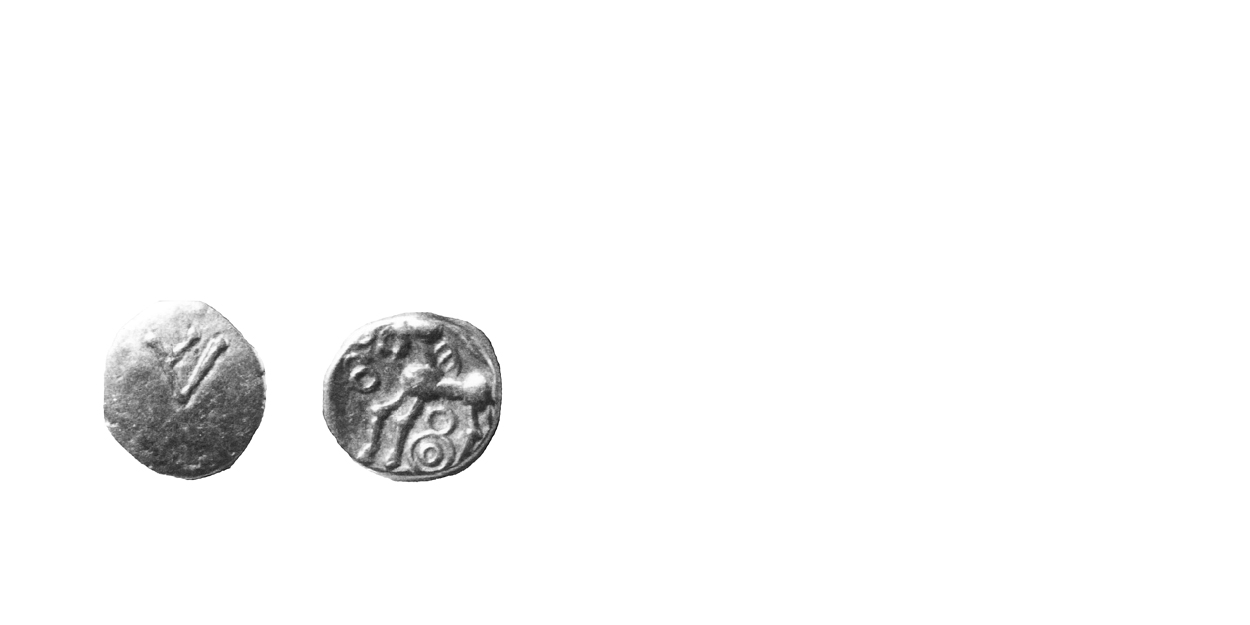
353 - 01 Upright E Type
45-30 B.C. Extremely Rare
Gold Quarter Stater 1.35 gms. 8 mm
Earliest Record: Evans, 1864
OBV: Digamma on blank field
REV: Celticized horse left
Identifying points:
1) below horse, figure-of-eight with ring in lower loop
2) 'E' symbol above horse, with arms of E pointing right
3) middle arm of E is bent downwards
4) mane made up of curve with lines
5) CO in front of horse
6) double-stranded tail
CLASSIFICATION: Atrebatic C
NOTES:
- Standard weight given
- Celtic Coin Index records indicate rarer than originally thought
- Continental type, possibly of of Commius exists, see 87 - 01
- Many in museums
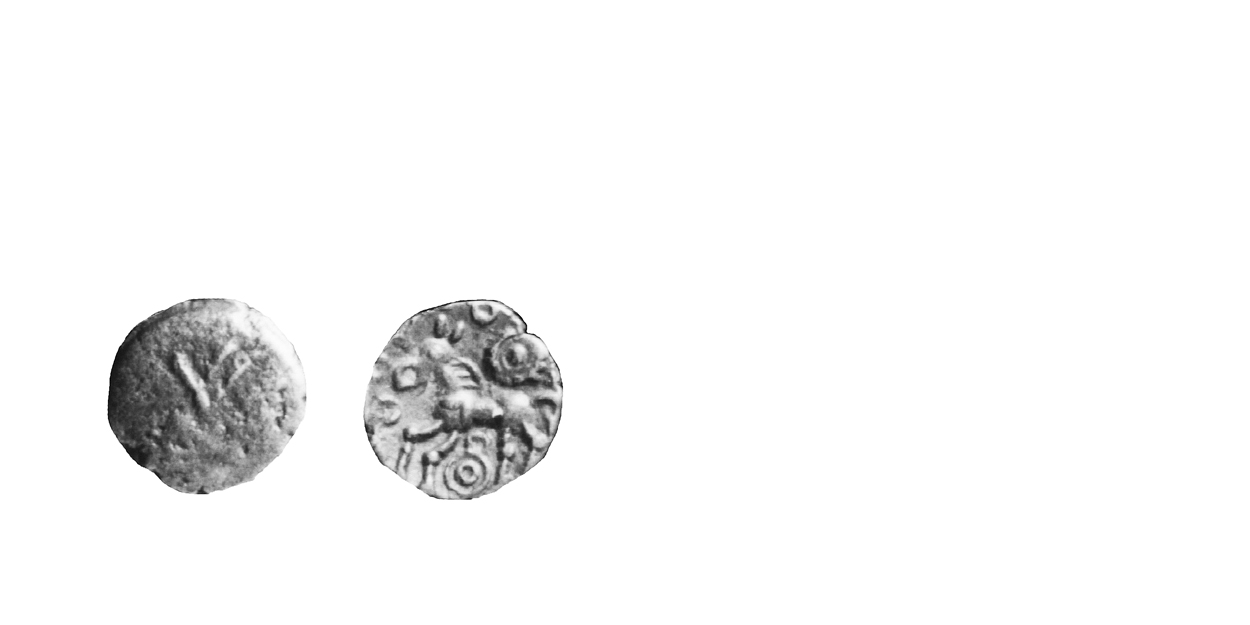
353 - 05 Anemone Type
45-30 B.C. Scarce
Gold Quarter Stater 1.35 gms. 9 mm
Earliest Record: Van Arsdell, 1989
OBV: Digamma on blank field
REV: Celticized horse left
Identifying points:
1) below horse, figure-of-eight with ring in lower loop
2) anemone above horse
3) mane made up of curve with lines
4) double-stranded tail
CLASSIFICATION: Atrebatic C
NOTES:
- Standard weight given
- Continental type, possibly of Commius
- Modern forgery exisits: see – (353-05-F1)
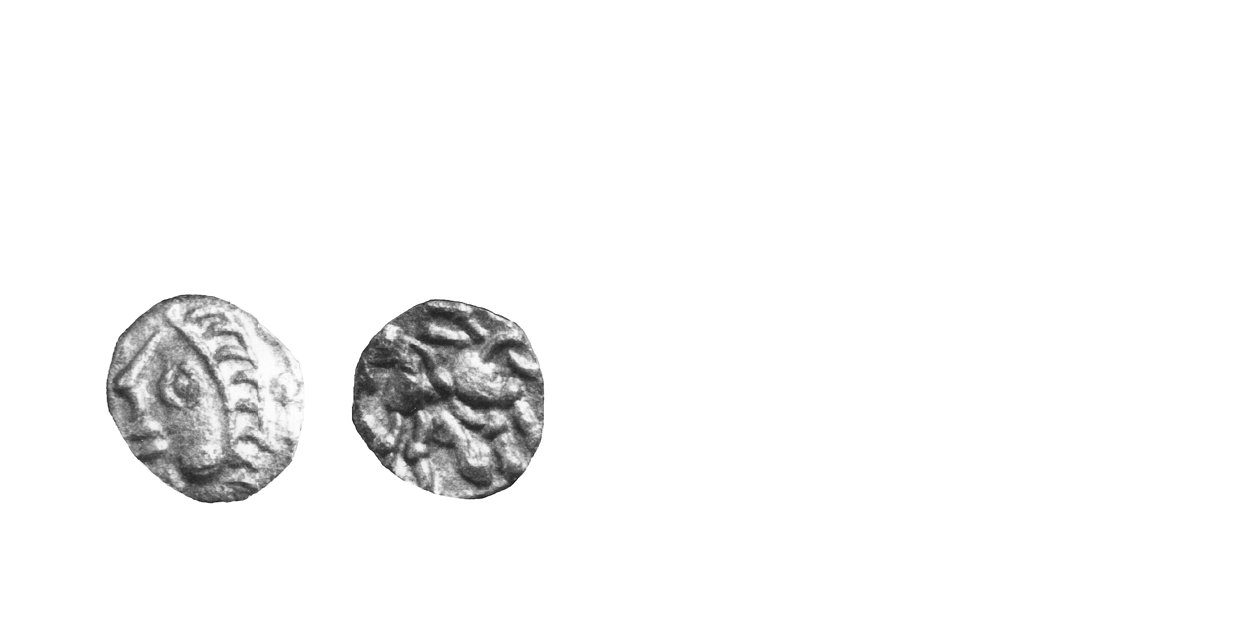
355 - 01 Commius Upright E Type
30-45 B.C. Very Rare
Silver Unit 0.9 gms. 11 mm
Earliest Record: Evans, 1864
OBV: Celticized head left
Identifying points:
1) "curved ladder" for hair
2) eye is crudely-engraved pellet-in-ring motif
3) scroll in front of face
REV: Celticized horse left
Identifying points:
1) backwards "S" shape below horse
2) "E symbol" above horse, with arms of E pointing right
3) middle arm of E is bent downwards
CLASSIFICATION: Atrebatic C
NOTES:
- Some in museums
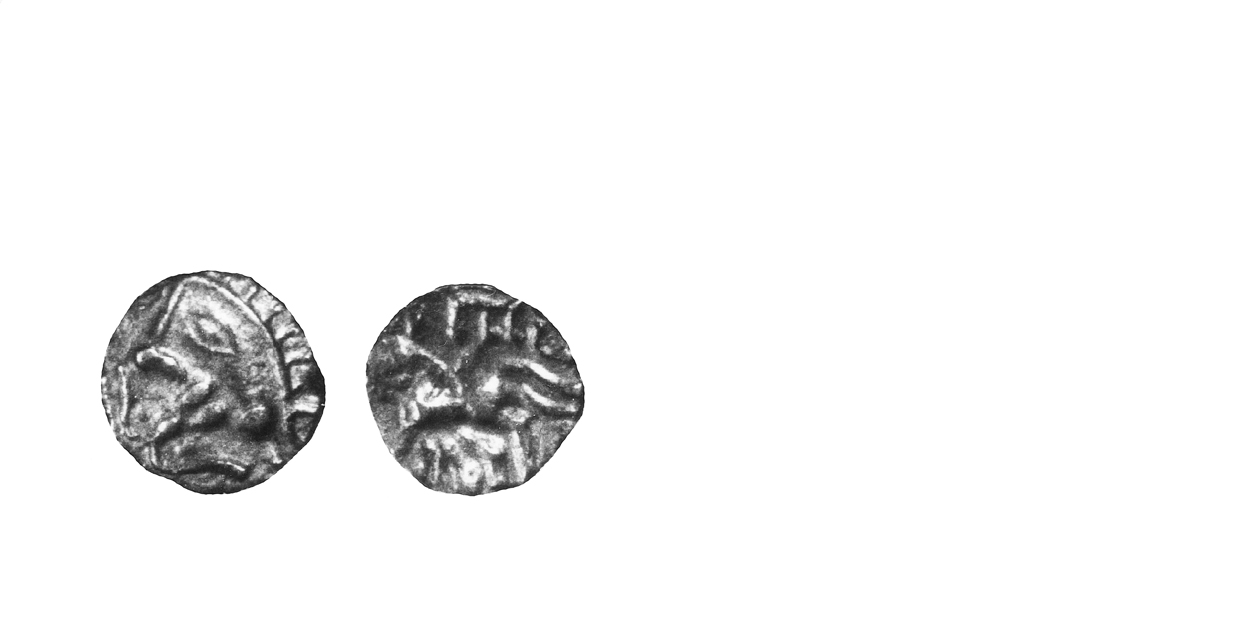
355 - 03 Commius Lazy E Type
45-30 B.C. Scarce
Silver Unit 1.0 gm 12 mm
Earliest Record: Poste, 1853
OBV: Celticized head left
Identifying points:
1) as 355 - 01
REV: Celticized horse left
Identifying points:
1) as 355 - 01
2) arms of "E symbol" point downwards
CLASSIFICATION: Atrebatic C
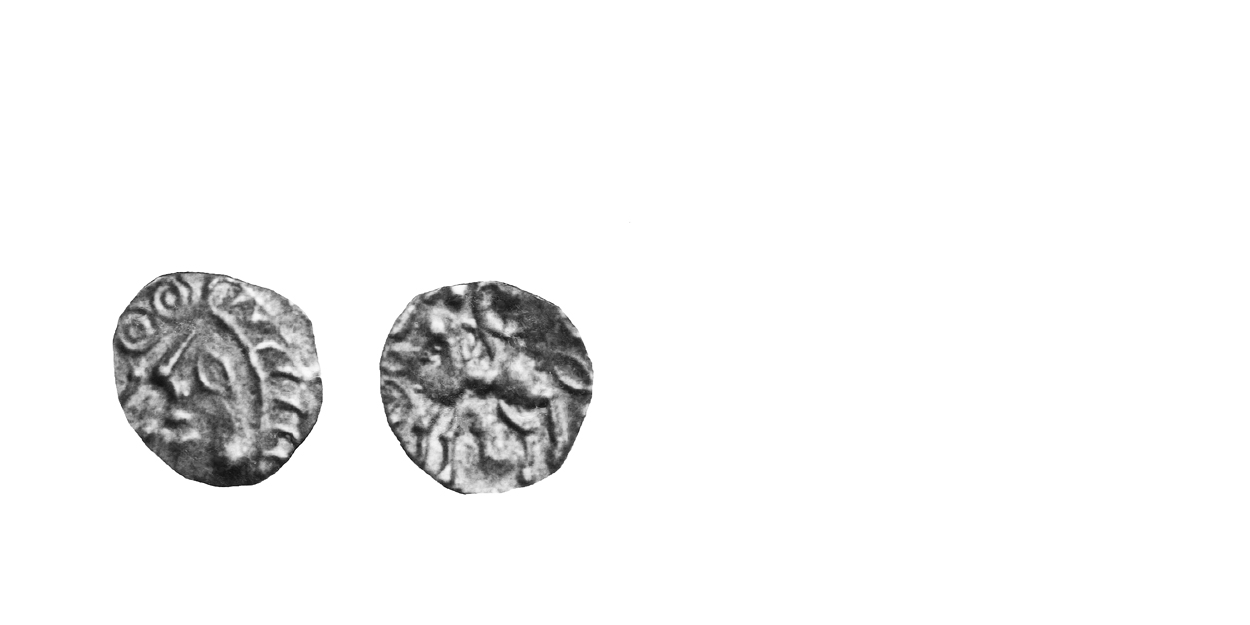
355 - 05 Commius Wheel Type
30-45 B.C. Very rare
Silver Unit 11 mm
Earliest Record: Van Arsdell, 1989
OBV: Celticized head left
dentifying points:
1) "curved ladder" for hair
2) eye is crudely-engraved pellet-in-ring motif
3) two pellet-in-ring motifs in front of face
REV: Celticized horse left
Identifying points:
1) backwards "S" shape below horse
2) eight (?)-spoked wheel above horse
3) mane made up of curve with lines
4) double-stranded tail
CLASSIFICATION: Atrebatic C
NOTES:
- Some are in museums
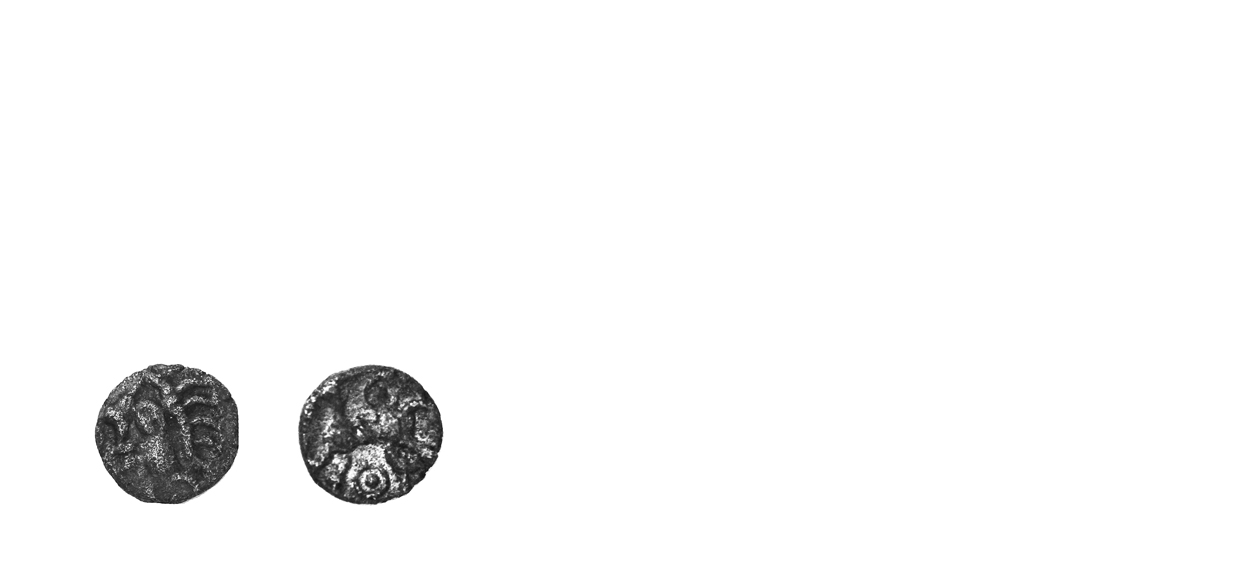
358 - 05 Commius
30-45 B.C. Very Rare
Silver Minim 0.35 gms. 7.5 mm
Earliest Record: Van Arsdell, 1989
OBV: Celticized head left
Identifying points:
1) "curved ladder" for hair
2) eye is crudely-engraved pellet-in-ring motif
REV: Celticized horse left
Identifying points:
1) backwards "S" shape below horse
2) pellet-in-ring motif above and below horse
CLASSIFICATION: Atrebatic C
NOTES:
- Weight given is that of an existing example
- Some are in museums
- The wheel above the horse has been replaced by a pellet-in-ring motif owing to the small size of the flan
362 - 01 Deleted
Johns Sills reports an example with a better reading of the legend. The stater is now seen to be the same as 405 - 01, and thus 362 - 01 has been deleted from the catalogue.
(See 405-01)
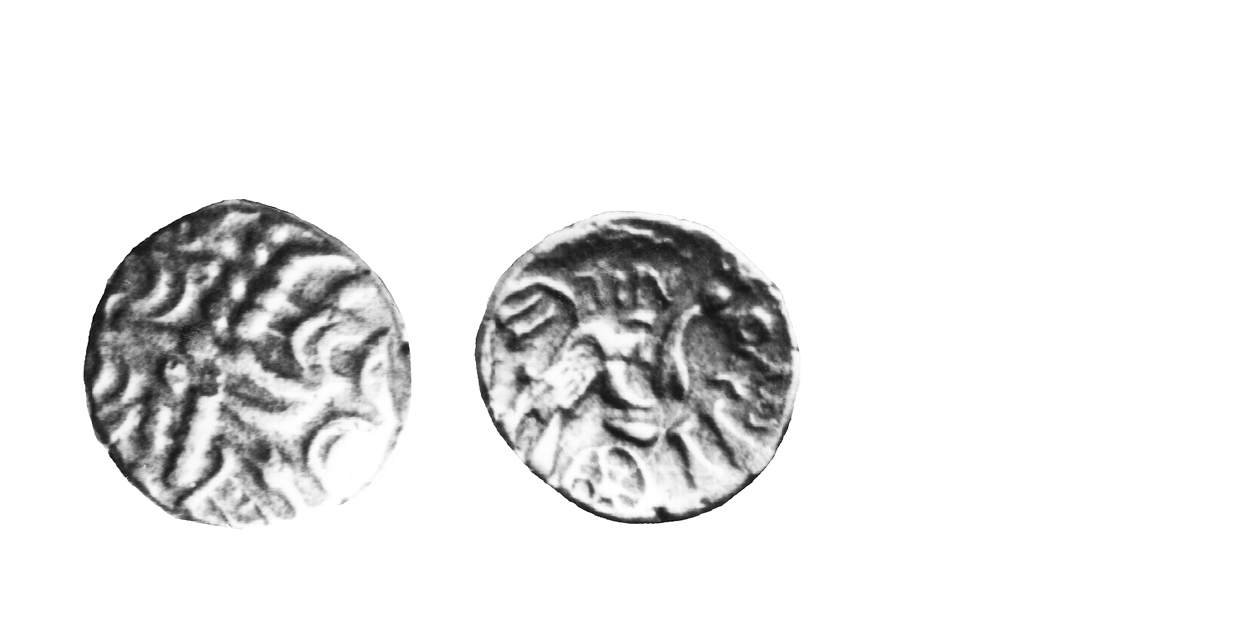
363 - 01 Tincomarus First Coinage
30-25 B.C. Rare
Gold Stater 5.45 gms. 17 mm
Earliest Record: Poste, 1846
OBV: Celticized head of Apollo right
Identifying points:
1) similar to 350 - 01
REV: Celticized horse right
Identifying points:
1) TIN DV around horse
2) triple tail
3) six-spoked wheel with axle below horse
CLASSIFICATION: Atrebatic D
NOTES:
- Standard weight estimated, the true standard is probably 0.1 to 0.2 grammes heavier
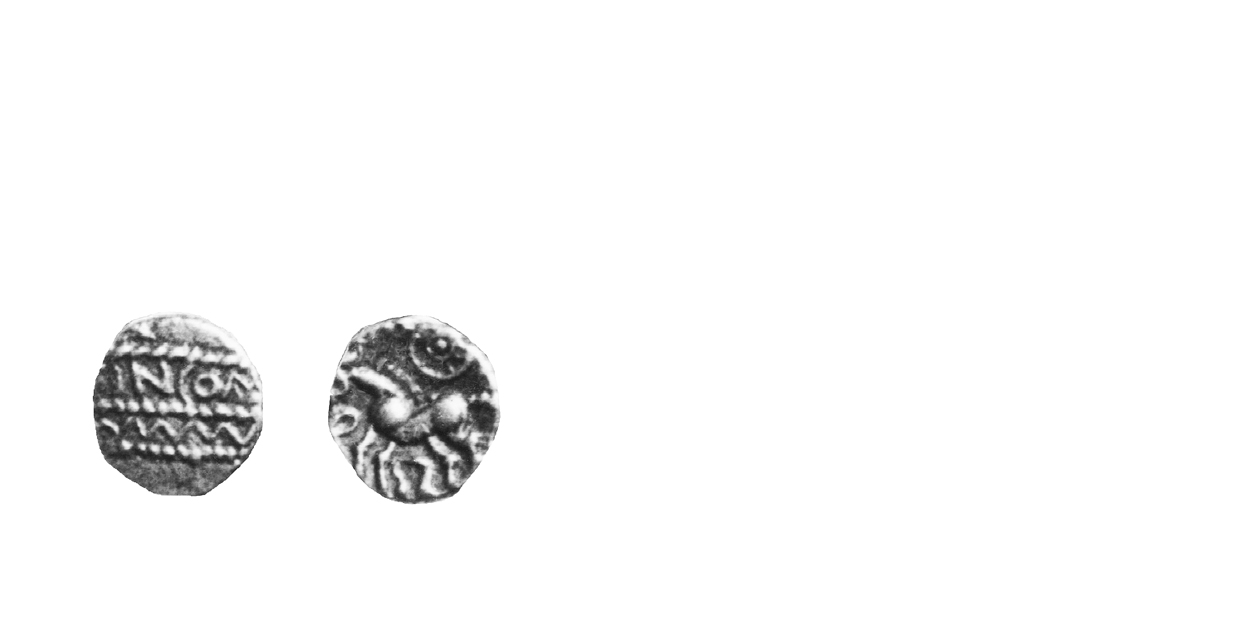
365 - 01 Tincomarus First Coinage
30-25 B.C. Very Rare
Gold Quarter Stater 1.2 gms. 10 mm
Earliest Record: Evans, 1864
OBV: Inscribed tablet
Identifying points:
1) TIN COM in two lines in tablet
2) COMM highly stylized underneath
3) lines of pellets above and below inscriptions
REV: Celticized horse left
Identifying points:
1) wheel and ring above horse
2) hook below horse
3) three rings in front of horse
CLASSIFICATION: Atrebatic D
NOTES:
- Typical weight given
- Most in museums
- Lewes Museum example clearly shows "COMM" inscription on obverse
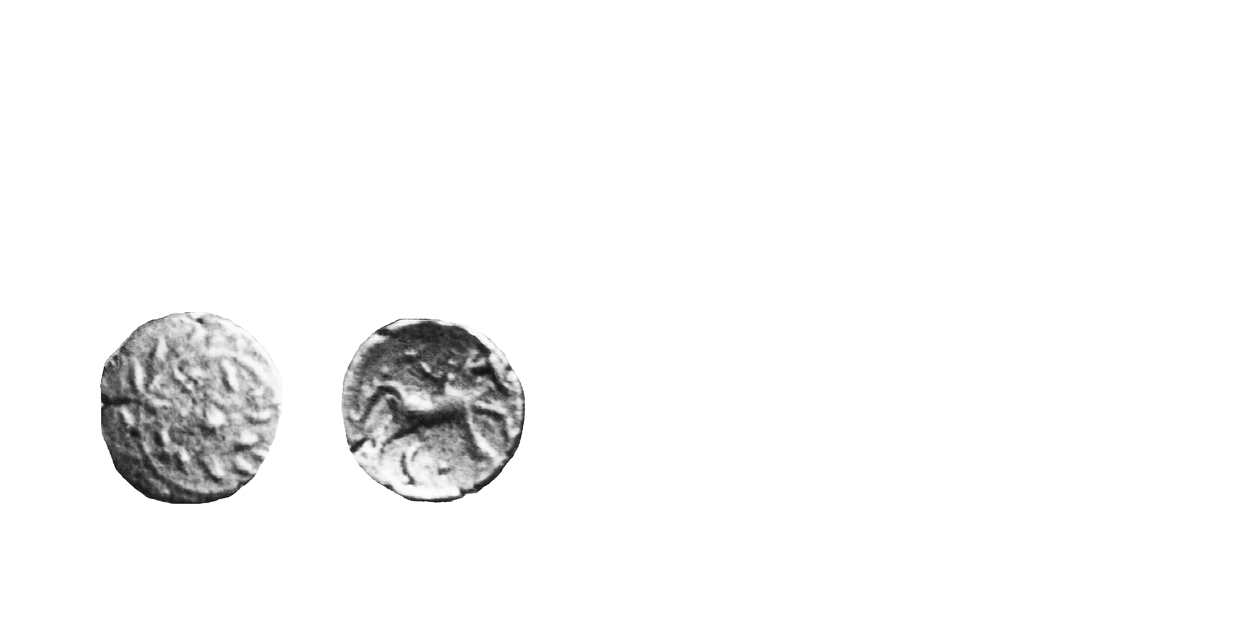
366 - 01 Tincomarus First Coinage
30-25 B.C. Rare
Gold Quarter Stater 1.2 gms. 10 mm
Earliest Record: Evans, 1864
OBV: Spiral
Identifying points:
1) multi-armed spiral with large pellet in centre
REV: Celticized horse right
Identifying points:
1) 'T' above horse
2) pellet below horse
CLASSIFICATION: Atrebatic D
NOTES:
- Many found at Wanborough
- Right most rear leg of horse is often weakly-struck, can easily be mistaken for the letter "C"
- Celtic Coin Index records indicate rarer than thought
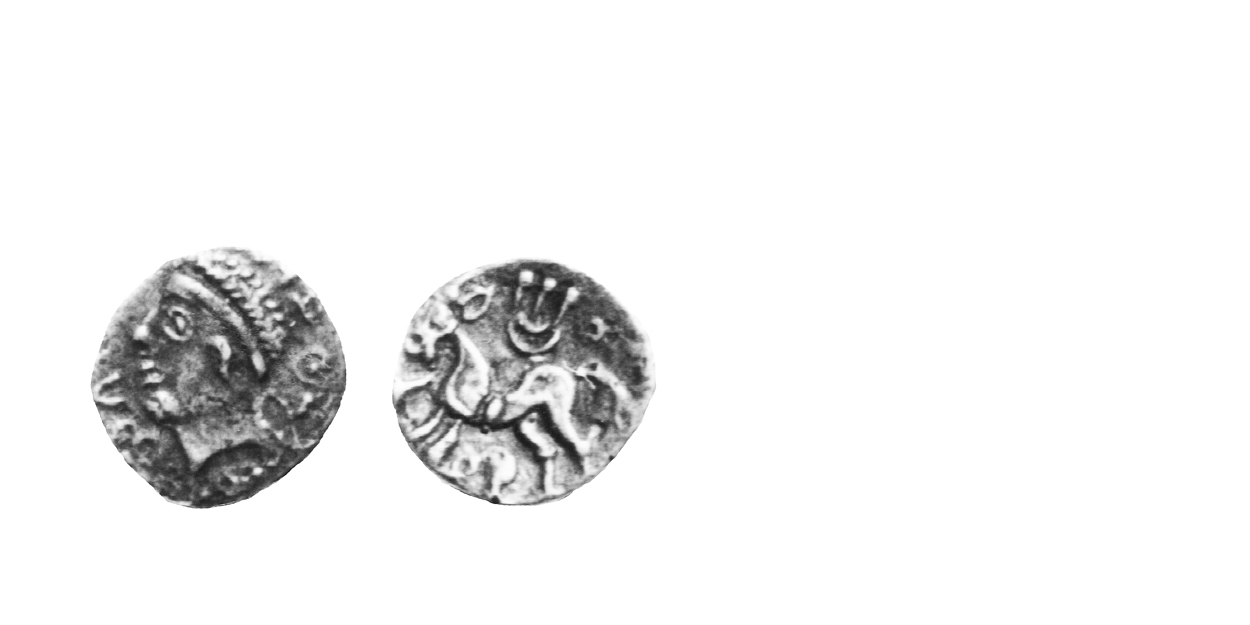
369 - 01 Tincomarus First Coinage
30-25 B.C Rare
Silver Unit 15 mm
Earliest Record: Evans, 1890
OBV: Celticized head left
Identifying points:
1) pellet-in-ring motif for eye
2) diadem made up of a line
3) inscription around head, probably TINC
REV: Celticized horse left
Identifying points:
1) outline crescent above horse with three lines rising above it
CLASSIFICATION: Atrebatic D
NOTES:
- This type was traditionally attributed to Verica, but noted as possibly an earlier type
- It is now felt that the legend reads TINC
- Previously listed as 473 - 01
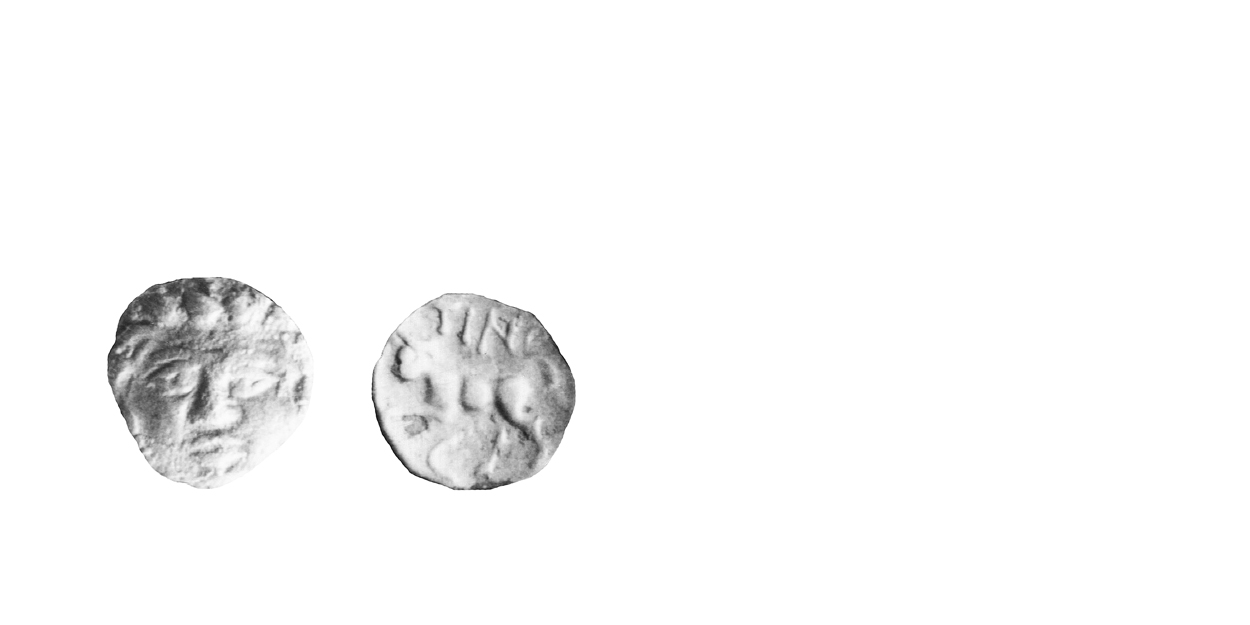
370 - 01 Tincomarus First Coinage
30-25 B.C. Very Rare
Silver Unit 1.1 gms. 12 mm
Earliest Record: Van Arsdell, 1989
OBV: Celticized head facing
Identifying points:
1) rounded face
2) thick hair
REV: Bull left
Identifying points:
1) TIN above bull
2) C below bull
3) pellet below tail
CLASSIFICATION: Atrebatic D
NOTES:
- Many found at Wanborough
- Celtic Coin Index records indicate rarer that originally thought
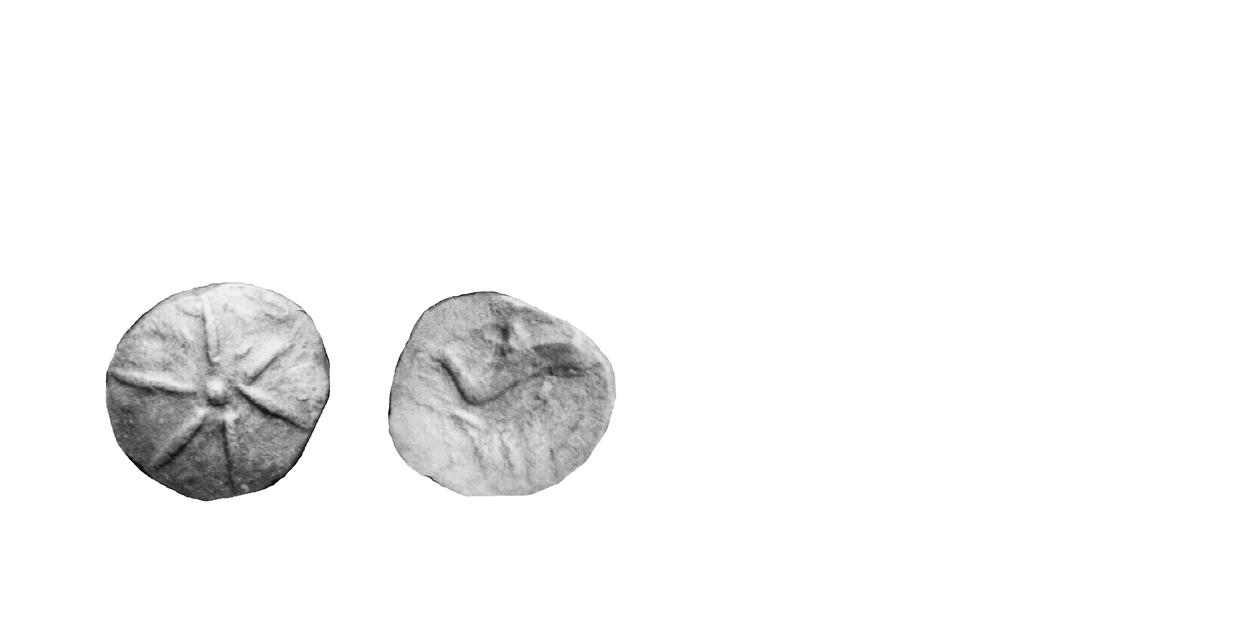
371 - 01 Tincomarus First Coinage
30-25 B.C. Scarce
Silver Unit 1.2 -1.3 gms. 12 mm
Earliest Record: Van Arsdell, 1989
OBV: Wind flower
Identifying points:
1) six petals on wind flower
2) central pellet
REV: Boy riding dolphin right
Identifying points:
1) TINC in field
CLASSIFICATION: Atrebatic D
NOTES:
- Many found at Wanborough
- Seldom well-struck, the reverse is usually difficult to see
- Reverse adapted from a denarius of L. Lucretius Trio
- Letters, weakly-struck, have been reported on the obverse.
- Celtic Coin Index records indicate rarer than originally thought
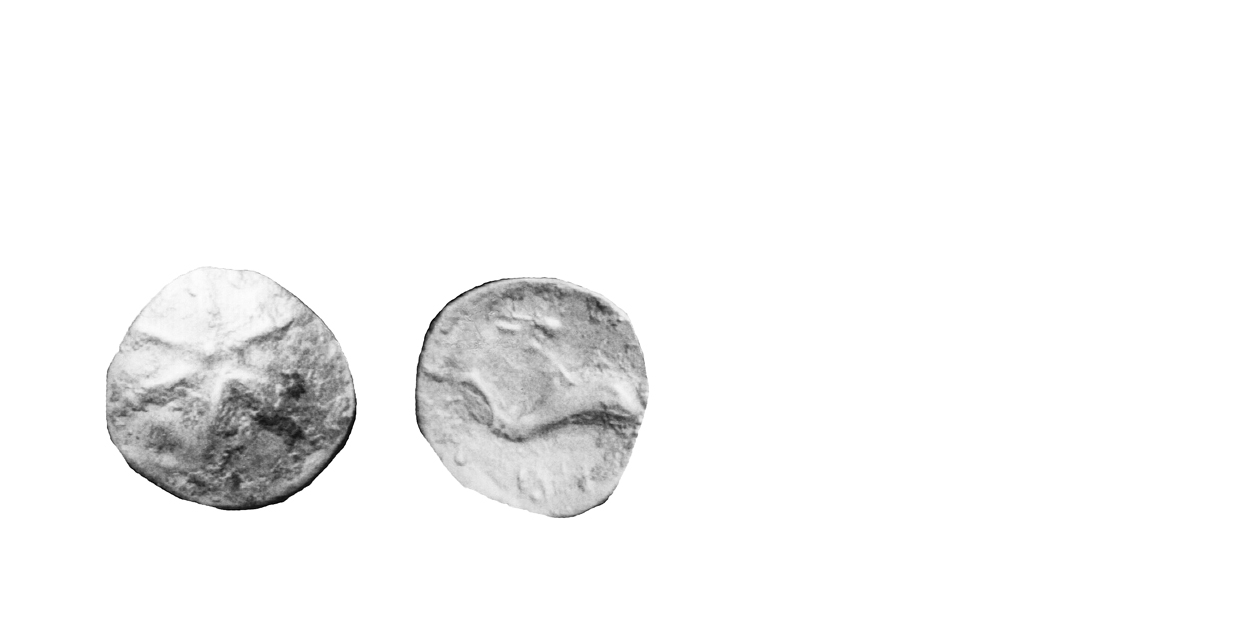
371 - 01 Tincomarus First Coinage
30-25 B.C. Scarce
Silver Unit 1.2 -1.3 gms. 12 mm
Earliest Record: Van Arsdell, 1989
OBV: Wind flower
Identifying points:
1) six petals on wind flower
2) central pellet
REV: Boy riding dolphin right
Identifying points:
1) TINC in field
CLASSIFICATION: Atrebatic D
NOTES:
- Many found at Wanborough
- Seldom well-struck, the reverse is usually difficult to see
- Reverse adapted from a denarius of L. Lucretius Trio
- Letters, weakly-struck, have been reported on the obverse.
- Celtic Coin Index records indicate rarer than originally thought
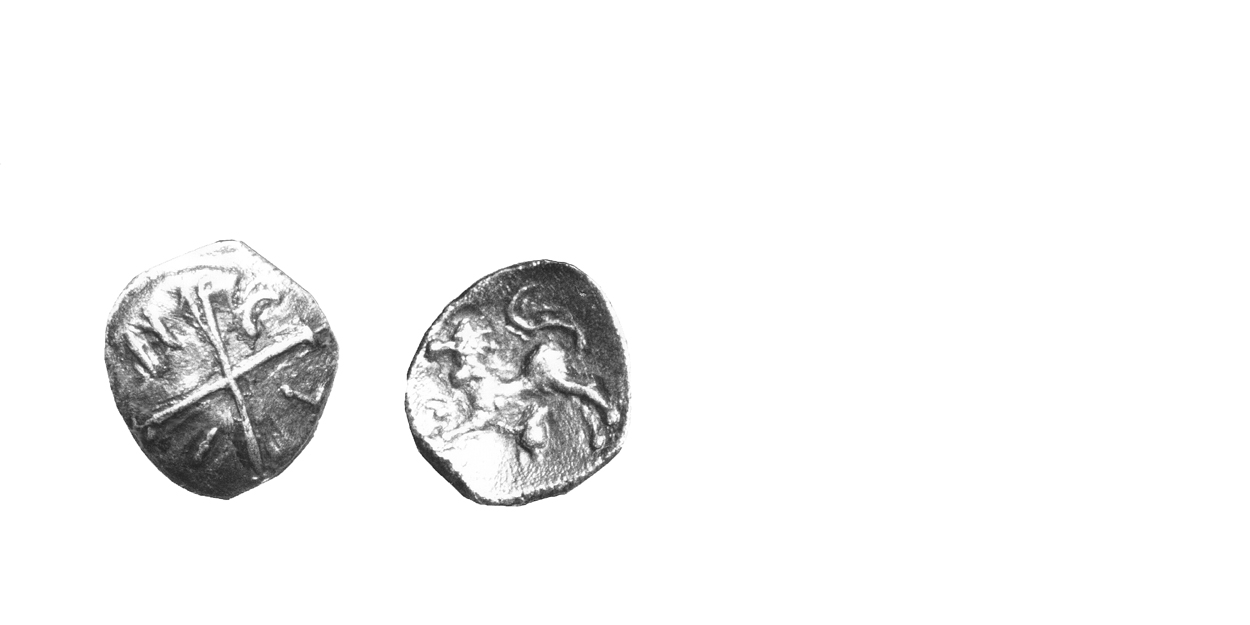
372 - 01 Tincomarus First Coinage
30-25 B.C. Rare
Silver Unit 13 mm
Earliest Record: Van Arsdell, 1989
OBV: Inscription in cross
Identifying points:
1) cross made up of two lines
2) TINC in angles
REV: Lion left
Identifying points:
1) S-shaped tail
CLASSIFlCATlON: Atrebatic D
NOTES:
- Type possibly found at Wanborough
- Celtic Coin Index records now confirm commoner that originally thought
- Not authenticated via metallurgical analysis, but type appears plausible
Coinage of the Atrebates, Regni & Belgae
The Atrebates, Regni and Belgae occupied the territory that is today Berkshire, Sussex and Hampshire. Whether three distinct political groups struck coins cannot be proven today, nor can separate territories be demonstrated. The Regni are virtually unknown to history until the Roman period, and the tribal area of the Belgae is a matter of controversy. Though Belgic immigration is mentioned by Caesar, he does not specifically say where they settled, and we only have the Roman name Venta Belgarum to suggest a location. The Atrebates, also mentioned by Caesar, had tribal members on both sides of the Channel.
Traditionally, the three tribes have been treated numismatically as one. Based on the current state of research, there is no reason to change this approach. Attempts have been made to identify a separate coinage for the Belgae. These have been largely, but not entirely, based on reports of new types of silver coins published in numismatic trade lists since 1994. The coins do not appear to form a coherent issue of a single issuing authority and questions exist regarding their precise status. These enigmatic coins demand careful analysis and reflection before they are accepted as evidence for a Belgic coinage. Certainly, after the Gallic War, only one coinage circulated in the territory. It may someday come to pass that coinages for the Belgae and Regni can be identified, but only after a rigorous analysis of the new types has been completed. Most of these are listed under "New Material". For the remainder of this discussion the three tribes will be referred to simply as the "Atrebates" for the sake of brevity.
Initially, the three tribes constituted one of the most advanced groups in Britain. They had trading contacts with Belgic Gaul in the late second and early first centuries B.C., and were one of the earliest to strike coins. The earliest stater, the INSULAR TYPE struck before the Gallic War, is derived from imported Gallo-Belgic C. The next coinage, the WESTERHAM TYPE, is now felt to be inspired by the Trinovantian/Catuvellaunian coinage of the same name, struck during the Gallic War. After the war, the tribal position changed dramatically, and the Atrebates may have fallen out of favour with the Romans. It is possible the cross-Channel trading rights were given to the Trinovantes/Catuvellauni instead. A loss of trading rights may have been the result of Commius' activities during the War.
Commius, at first a supporter of Caesar, became disillusioned with the Romans and went over to Vercingetorix. After the collapse of Celtic resistance at Alesia, he fled to join the British part of his tribe. Later, the Atrebates struck coins with his name, and possibly the acceptance of Commius in Britain was the reason they fell out of favour. The change in trading rights altered the relative fortunes of the two tribes forever. By the end of the millennium, the Trinovantes/Catuvellauni had economic influence throughout southern Britain and had begun to rival the Atrebates.
The Atrebates seized the opportunity of the Trinovantian/Catuvellaunian Interregnum to mount a military incursion into Kent under their leader, Eppillus. Eppillus struck a victory stater commemorating the initial success of the expedition. The incursion was cut short, however, by the elevation of Cunobeline to the Trinovantian/Catuvellaunian throne. He drove the Atrebates out of Kent and Eppillus promptly disappeared. He is replaced on the coins by Verica, a self-styled 'son of Commius'.
Sometime before the Claudian invasion, Verica was in turn overthrown. He probably was the historical Celtic leader 'Bericus' who appeared in Rome seeking aid from Claudius. Verica was replaced on the coins by Epaticcus, who styled himself a 'son of Tasciovanus'. Whether the family-tie was real is not so important, the result was the Atrebatic leadership was now held by a Trinovantian/Catuvellaunian sympathizer. Shortly before the Claudian invasion, Epaticcus was replaced by Caratacus, the famous leader of the British resistance against the Roman invaders. The Atrebatic coinage came to an end during the forties, as Caratacus fled westwards to lead the resistance amongst the tribes in Wales. One Atrebatic leader known to history, Cogidubnus, has not yet been identified on the coinage. It seems he was not elevated to leadership until the coinage had come to an end.
